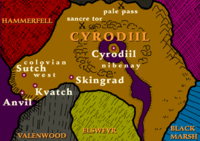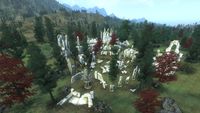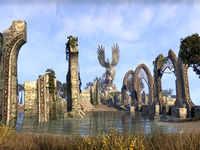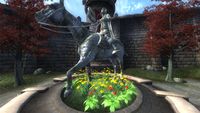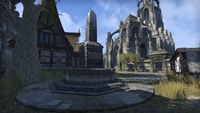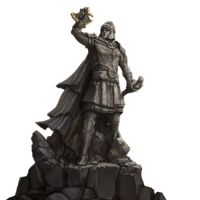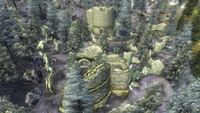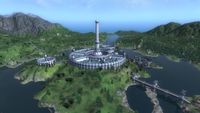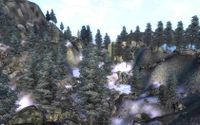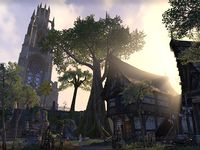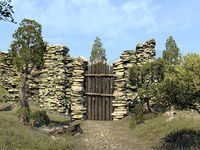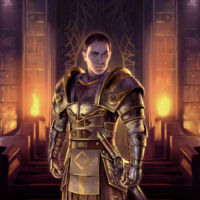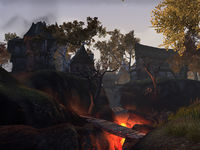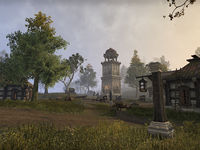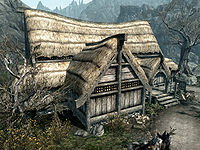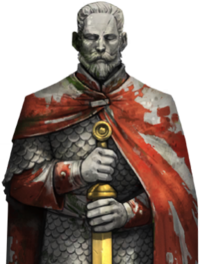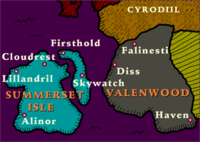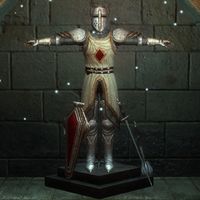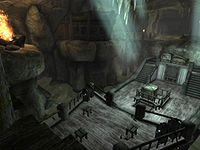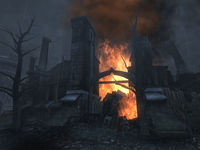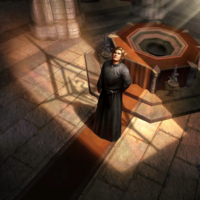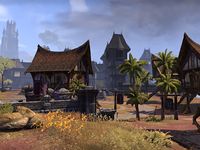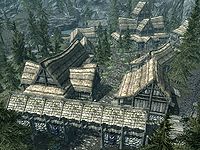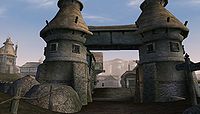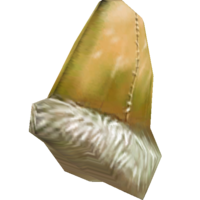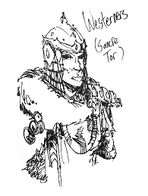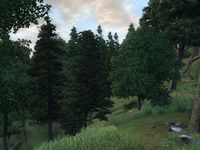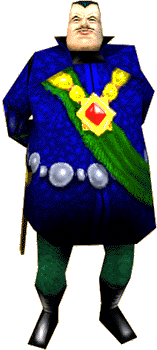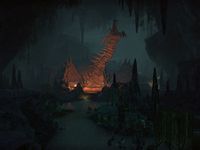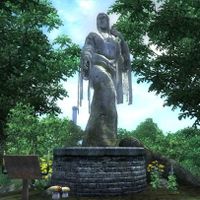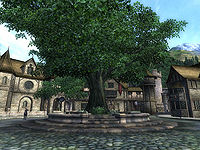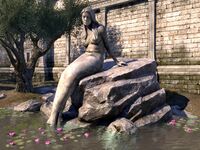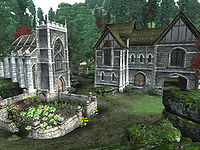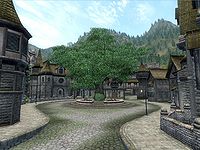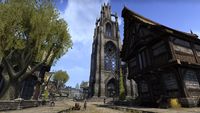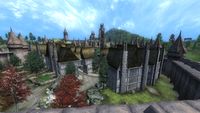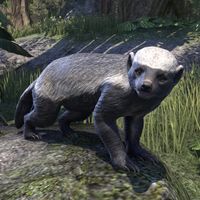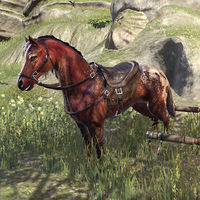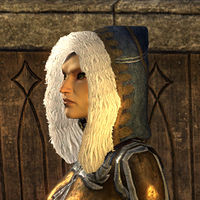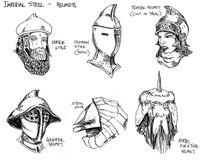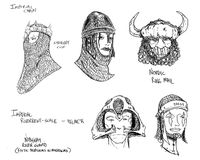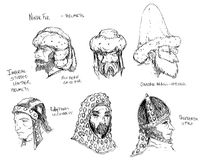Lore:Colovia
| Colovia | |
|---|---|
| Type | Region |
| Continent | Tamriel |
| Province | Cyrodiil |
| Demonym(s) | Colovian |
| Appears in | Oblivion, ESO |
|
Colovia (also known as the Colovian West,[1] Old Colovia,[2] and the Imperial West)[3] is the western half of the province of Cyrodiil, known for their austere, hard-working, and self-sufficient people, the frontier-men of Colovia. The Imperials of Colovia are strong-headed and hard working, with a rich martial tradition and strong work ethic. Many serve in the Imperial Legion, either as soldiers or commanders,[1] and Colovian Timber is highly prized for both construction and weaponry.[4]
Colovia features rugged hillscapes throughout the Gold Road, dense greenery in and around the Great Forest, and wide swathes of open grasslands throughout the Imperial Reserve, which is famous for its bountiful hunting grounds. Most of the Colovian population live in the major cities, but some, particularly the nobility, tend to live in private estates closer to the Gold Coast,[5] while various farms and roadside inns dot the landscape. Colovia has also been described as a coastal jungle.[1] Though Colovia's borders have shifted throughout the eras, traditionally, it contains four counties and their cities: Anvil, Chorrol, Kvatch, Skingrad, and formerly Sutch.
Contents
- 1 History
- 1.1 Early History
- 1.2 King Rislav Larich, the Righteous Son of Colovia
- 1.3 Bendu Olo and the All-Flags Navy
- 1.4 The Schism of Cyrodiil and the Light of Man
- 1.5 Colovia in the Second Empire
- 1.6 The Interregnum and Varen Aquilarios
- 1.7 Colovia and the Soulburst
- 1.8 Talos Stormcrown and Emperor Zero
- 1.9 Colovia in the Tiber War
- 1.10 Under the Third Empire
- 1.11 At the turn of the Third Era
- 1.12 Colovia in the Fourth Era
- 2 The Colovian Estates
- 3 Culture
- 4 Notable Locations
- 5 Gallery
- 6 Notes
- 7 References
History[edit]
- For the history of the province, see the: History of Cyrodiil
Early History[edit]
Before the Colovians lived in the Cyrodilic West, the region contained the western half of the once almighty Ayleid Empire. Many great city-states and kingdoms dotted the landscape, such as the prosperous Ceyatatar[6] and the independent state of Lindai.[7] One of the most powerful nations from the west was Miscarcand, the great capital of a mighty kingdom.[8]
However, all of these once-powerful countries fell to the whim of the First Cyrodilic Empire and have either tried to retaliate or broker alliances with them, but in time, they were all abandoned. For example, the home of the Guiding Light, Garlas Malatar, sealed itself away from the outside world and was sacked by the Alessians only from the outside. It perished from the inside by unknown means.[9] The remaining Ayleids in Colovia either became servants of the people that soon took over,[10] or continued to live on in tribes as the Wild Elves, far from the civilizations of Tamriel.[11]
In the years that followed the Alessian Slave Rebellion, the land was soon populated by the Nedes and later the ancient Cyro-Nords. The former had built port cities along the Strident Coast. Meanwhile, the latter had come to Colovia hoping to conquer the newly-established frontier, and distance themselves from the use of magic or the need for industry in the Nibenay. They preferred the engagement and plundering lifestyle like their predecessors in Skyrim. After they dominated the Nedic society of Colovia,[1] they became more unified and formed great kingdoms that continue to thrive in the present-day, such as Skingrad and Kvatch. These countries were typically ruled by a King,[10] but some (such as Kvatch) were also governed by a regency council of three lords.[12] They also took their conquest to the seas, as far away as the Blue Divide and the Iliac Bay, where they annually raided ports for roughly seven centuries until the arrival of the Ra Gada in 1E 808.[1][13]
Sometime after Alessia's reign, the monkey-prophet, Marukh emerged from the coastal jungles of Colovia and preached to the masses about his experiences with the "Enlightened One", ushering a new religious movement that became the Alessian Order. At the height of the Order's influence, the West founded an autonomous government called the Colovian Estates, which had firmly established a solid position, both geographically and politically that resisted the East and their doctrines. From then on, these two faces of Cyrodiil had forever changed the perception of the province from the outside.[1]
King Rislav Larich, the Righteous Son of Colovia[edit]
These two identities first clashed in 1E 478 when the royal family of Skingrad succumbed to a deadly plague, and the throne was given to the oldest surviving child, Dorald Larich. Dorald had returned after his tenure as an Alessian priest in the Imperial City, and his first edict on the first day of his reign was to cede the independent kingdom of Skingrad to the First Empire. The reaction across the Colovian Estates was shock and outrage, and all the more so in the Court of Kvatch where his younger brother, Rislav Larich was the prince. Prince Rislav and his wife, Princess Belene rode east with his father-in-law's cavalry to confront his brother. Rislav faced Dorald in the castle courtyard. In typical Colovian fashion, Rislav executed his brother on the spot instead of holding a trial. By right of combat, Rislav Larich was named the King of Skingrad and openly rebelled against the Alessian Empire and their methods. Emperor Gorieus and his armies poured onto the west "like a flood of death", with numbers that far exceeded the requirement to conquer a ruined Colovia.[10]
The Alessians anticipated little resistance and eventually surrender from the Colovians and an ill-experienced King Rislav. But the Colovian monarch called to arms and prepared a plan to thwart the Emperor. Both armies met at a low pass along what is now the Gold Road. Before Gorieus' personal guards would arrest the King, Rislav signaled his archers to rain a storm of arrows onto the pass and escaped westward. With nowhere to run, the Imperial Army was left devastated by the surprise attack, and they were forced to pursue Rislav northwest into the southern Colovian Highlands. As their armies became smaller and smaller, they were met by King Justinius of Kvatch and a volley of arrows from his troops. The Emperor's army had greatly dwindled and was forced to retreat into the Imperial Reserve before they returned to Nibenay.[10]
Rislav's resounding victory was the beginning of the end for the Alessian Hegemony, as the other Colovian kingdoms joined Skingrad and Kvatch in their rebellion. King Rislav Larich became a hero in the eyes of the West and earned the sobriquet of "the Righteous". His likeness is a treasured landmark in Skingrad's Hightown and his actions inspired others to fight back. Most notably the Direnni under Ryain Direnni, who fought against the Alessians in the Battle of Glenumbra Moors around 1E 480 and outlawed their religion. His territory expanded east and pressed southeast into Imperial territories[10] where at some point, they harassed the Colovian West and pushed into the Heartlands until their defeat in 1E 492.[14]
[edit]
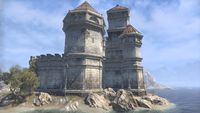
By the turn of the twenty-third century in the First Era, the tension between the East and the West persisted, but for a long time, they were part of one Empire. While the Nibenese flourished in their wealth, the Colovians trudged onward. The Colovian Estates had expanded beyond Cyrodiil in the past several centuries, incorporating other settlements across the region like the Strident port of Anvil, the northern hold of Falkreath, and other places like Delodiil and Sarchal.[15] However, in 1E 2200, all of Western Tamriel faced severe casualties when the Thrassian Plague decimated half of the continent's population,[16] and obliterated ancient established dominions like the sixteen kingdoms of Elsweyr[17] and the sovereignty of Summerset's kinlords.[18]
After years of suffering, the Colovian king of Anvil, Bendu Olo loudly called for justice against the Sload and petitioned the Emperor for commission, to which he received in short notice in 1E 2241. With the self-claimed title of Baron-Admiral and in the span of two years, Olo assembled one of the largest naval forces in history called the All-Flags Navy.[19] The navy's founding leaders originally gathered on Stirk, an island west of Anvil[20] and assembled west across the Abecean Sea on the Systres,[19] an archipelago northwest of Lillandril.[21] Colovian engineers spearheaded the construction of the island's shipyards in Gonfalon Bay and later the All Flags Islet, a monument to the navy. The war against the Sload started sometime in 1E 2258 and ended with the final siege against Thras in 1E 2260.[19]
After the battle, the remaining captains of the All-Flags Navy returned to the Systres and signed the Concordat of Fraternity, which bound each captain and each race to peace and allowed the Systres to stand as a monument to Tamriel's victory.[19] Bendu Olo claimed the Systres Archipelago as an extension of Colovia and while all of the fleet's captains returned home, Colovians and Bretons stayed and work with Master Builder Tobin Moorcroft to construct a monument to the navy. That edifice, the Colossus of Gonfalon Bay finished construction more than twenty years later in 1E 2290 and stands today on the southeast shore near the eponymous city.[22][23] Bendu Olo and his fight against the Sload brought immense glory to the Cyrodilic people[1] and established trade with the other races like the Redguards.[24] Over time, the Colovian Estates greatly overshadowed Nibenay, so much so that tension raised between both factions.[1]
The Schism of Cyrodiil and the Light of Man[edit]
Even though the Systres was a Colovian state, it was mostly populated by Bretons and the Alessian Emperor demanded that they left. The Colovians, however, did not budge and insisted that the cost of removal was prohibited. The Associate Dean of Eltheric History at the University of Gwylim, Trilam Heladren asserts that this was the Colovians' attempt to bid their time for independence from the Alessians.[22]
What came after was the War of Righteousness in 1E 2321, which started because of a number of factors. The estates over time became bolder and resistant to the Alessian doctrines, all the more so when the east failed to re-capture High Rock. This and internal conflict in the Alessian Order were what led to the War of Righteousness and its ten years of a desperate back and forward.[1] The coffers of both sides emptied to gain an advantage over the other and in 1E 2326, the Colovian Estates were out of money. Their kings had to sell any non-essential territory to meet the demand, such as the Systres which was sold in 1E 2327 for an undisclosed sum.[22] The war came to an end in 1E 2331 and both the order and the First Empire had disbanded.[1] What followed was four hundred years of separation as each side were shadows of their former glory. The Colovian kings were taken by their greed and pride, and became more like thief-barons, forsaking their covenants.[15]
As the story, the Remanada goes, King Hrol of lost Twil received visions of an invasion in the near future and sought to heal the borders of his forebears with his western knights. In their journey, they met the spirit of Alessia, who wielded the dragonfire of Akatosh and the Amulet of Kings. When she fled north, they scoured the land to find her and both Hrol and his shieldthane found her in the Colovian-Jerall region. The shieldthane witnessed the spirit undress in front of the king and copulate on a mound of mud. He then carved onto a rock, "AND HROL DID LOVE UNTO A HILLOCK" before dying on sight. The other knights discovered Hrol dead on the mound and parted ways after, either because they went mad or returned to Twil ashamed of their lord. Nine months later, the mound turned into a small mountain and was surrounded by a community of shepherds and bulls who named it Sancre Tor. One fateful day, the shepherdess, Sed-Yenna scaled the mountain when she heard the cries of a baby. At the top, she found an infant with the Amulet of Kings on his forehead. She named him Reman, the "Light of Man," and took him to the Ruby Throne in the White-Gold Tower, where he said, "I am Cyrodiil come.[15]
Colovia in the Second Empire[edit]
Reman is described as a "proud son of the West" like Bendu Olo before him. When the First Akaviri Invasion occurred in 1E 2703, he gathered the disparaged Colovians and rallied the Niben Valley's armies to meet the Tsaesci invaders at the Pale Pass. Reman unified the two faces of Cyrodiil and created the cosmopolitan Second Empire.[1] The Empire incorporated aspects of Colovia, as well as High Rock, Nibenay, and the strange but sophisticated cultures of the Akaviri.[25]
At some point in time, relations between the Second Empire and the Colovian West were strained until Empress Herda relieved them. This change in development gave the Empire extra leeway in their conquest of Valenwood, and their efforts paid off after centuries of war when they managed to annex the province in 1E 2714, with aid from the Thrassian Plague.[26] The Colovians left a significant footnote in the Kingdom of Grahtwood, specifically on the southern coast. The ancient settlement, Haven was reconstructed in the Colovian-style and it became a dominant power in the region.[27] Especially when it was given independence under a Treethane by the Empire.[26] Despite that, it was later overtaken by Southpoint to the west, built by a Colovian soldier Zantonius in 1E 2729. It has since become the center of Imperial culture in all of Valenwood and an important port in Grahtwood,[28][29] as well as the seat of a kingdom by the late-Third Era.[30]
When Reman's Empire came to fruition, it saw the Imperial Legion reform and bear influences from the Akaviri.[1] Colovian countrymen served in the Imperial Legion and some of their greatest contributions took place in the Empire's annexation of Valenwood. When the Colovians fought the Redguards in the War of Rihad circa 1E 2818, they utilized Wood Elf archers that proved to be too undisciplined and prone to desertion for further use.[31] At some point in time, Reman III married Tavia, an extremely wealthy noble with strong ties to the western Colovian Estates.[32]
The Interregnum and Varen Aquilarios[edit]
After many prosperous years under the Second Empire, the province of Cyrodiil was split once again with the assassination of Potentate Savirien-Chorak in 2E 431. Not only was Cyrodiil torn asunder, but it became no-man's land, a realm ruled by bandit-kings and false emperors. This long and tumultuous time in the Second Era was known as the Interregnum,[25] and while the province was left disheveled with no figurehead,[33] the Elder Council continued their service to the people. By the sixth century, Councilor Itinia served as Colovia's representative in the council and its affairs.[34]
Sometime in the mid-Second Era, Durcorach the Black Drake descended from the Reach in the north and took control of the Imperial City in 2E 533. Councilor Itinia was able to keep her position in the Elder Council with full confidence from Emperor Durcorach.[34] His ruling dynasty was known as the Longhouse Emperors and their Empire lasted longer than others before it, but because of their background and heritage, their rule was not recognized by the people of Cyrodiil.[33]
The relationship between the people and Longhouse Emperors was shaky, but tension reached its boiling point when Emperor Leovic revealed the Great Spirits Proclamation, which declared that worship of the Daedric Princes was legal and protected by the Empire. In secret, Duke Varen Aquilarios of Colovia made contact with the Emperor's Grand Chancellor, Abnur Tharn of Nibenay and together they plotted their revolution against the Emperor.[33][35] Duke Varen inspired the Colovians and rallied them to his cause, with his largest stream of support coming from the old nobility of Chorrol, Kvatch, and Skingrad.[36] But before he could advance onward to the capital, he felt that he needed to defend his homeland, the Gold Coast. The Duke enlisted the famed architect, Juros Truptor, and ordered his followers to build a stone wall between the Gold Coast and the rest of Colovia. The project enlisted many paid workers, an endless slew of volunteers, and every bit of stone available. From rough-hewn stone to mismatched rock and stone confiscated from noble estates, strategically placed in conjunction with the rocky, natural terrain.[37]
Duke Varen and the Second Legion left for the Cyrodilic heartland and after an initial defeat in Fort Ash, the Colovian Revolt made its way closer toward the Imperial City[35] until its resounding conclusion in 2E 577.[38] Back on the Gold Coast, the Longhouse's compound and retreat, the Black Drake Villa was plundered and most of Durcorach's treasure made its way into the black market.[39] In that same year, the pirate captain, Fortunata ap Dugal sailed into a barely protected and ungoverned Anvil with her fleet, the Red Sails and proclaimed herself its Provincial-Governor. Her first decree was to declare the Gold Coast's independence, from the Abecean Sea to Varen's Wall.[40]
Colovia and the Soulburst[edit]
Varen Aquilarios acquired his title through the right of conquest, with help from his chief advisor, Mannimarco. But like his predecessors, the Colovian Emperor did not have the blood of dragons in his veins and could not light the Dragonfires, as per tradition within the Empire. Mannimarco offered a solution that involved the long-lost Amulet of Kings. The Emperor assembled his Five Companions and scoured the land for the artifact until they found it in Sancre Tor in 2E 579. They returned to the Imperial City and the Temple of the One, where Mannimarco would have conducted a modified ritual that lit the fires, but instead opened a volatile rift between Nirn and Coldharbour called the Soulburst.[41]
Amid the chaos, Sai Sahan took the Amulet and hid it back in Sancre Tor,[42] but much to his detriment, both he and Lyris Titanborn were implicated in Varen's death.[41] The aftermath of the Soulburst was immediate and devastating.[41] Earthquakes ravaged central Cyrodiil and eventually split Chorrol in half, revealing a large fissure to the outer core of the planet. The people of Chorrol referred to the widespread destruction as the "Sundering".[43] The Soulburst paved the way for the Planemeld, Molag Bal's invasion over Tamriel and his takeover in Cyrodiil. The Order of the Black Worm built dark anchors all across the countryside, from the Applewatch Wood in the Colovian-Jerall region to Greenmead in the Great Forest.[44]
By the ninth century, central Cyrodiil was a shadow of its former self, plagued by highwaymen, necromancers, and now Daedra. The Colovians at this time were scattered and left to their own devices. While the Gold Coast continued uninterrupted as an autonomous state, settlements such as Chorrol and Vlastarus lived in a constant struggle with the elements.[44] However, the Colovian Estates between Varen's Wall and central Cyrodiil remained largely intact and continued their service to the Elder Council in earnest. At this point, Skingrad was ruled by Count Calantius, an ambitious leader and a canny opportunist. When the Mane went rampant in Reaper's March to the south, he re-designated the Northern Woods around Arenthia as the South Weald and sent the Legion of the West Weald to invade.[36][45]
With the Ruby Throne vacant, nations from across the continent continued to vie for control of the Imperial City. By 2E 582, the Alliance War had completely enraptured central Cyrodiil and turned it into a warzone. While County Skingrad and the Gold Coast were left untouched, eastern Colovia was torn between the Daggerfall Covenant to the north and the Aldmeri Dominion to the south. The former had acquired land from the western Jerall Mountains between Gnoll Mountain and Sancre Tor to the northern half of the Great Forest between Chorrol and Fort Ash. The latter acquired the rest of the Great Forest from Hackdirt and Fanacasecul, to the southern provincial border between Vlastarus and the Upper Niben. Major settlements at the time were Chorrol and Vlastarus, whose allegiances were determined by control over in Fort Rayles and Castle Brindle respectively. At the edge of their respective territories, the alliances established bases on provincial gates and built temples that housed Elder Scrolls[44] they stole from the Cult of the Ancestor Moth.[46] In that same year, a political feud ensued between Governor Fortunata ap Dugal of Anvil, Primate Artorius Ponticus of the Akatosh Chantry, and Count Carolus Aquilarios of Kvatch over supremacy on the Gold Coast. With intervention from the Dark Brotherhood however, the Count of Kvatch was the last one left alive,[47] and sought to bring stability to the entire region in the wake of the conflict.[48]
Talos Stormcrown and Emperor Zero[edit]
As the Alliance War came and went, there was no long-lasting successful claimant to the Ruby Throne, and the estates were scattered by the late Second Era. The Colovian King of Falkreath, Cuhlecain was at an impasse between the disorganized estates, which he wanted to unify, and his northern border toward the Reach, where the Nords and the Reachfolk had been at war for centuries. Before he could make his bid on the south, he sent his prized general, Hjalti Early-Beard of Alcaire, to lead his small force of Colovians and Nords against the Reach's line in Old Hroldan.[49]
According to The Arcturian Heresy, a siege appeared to be impossible to maintain due to the lack of possible reinforcements from Falkreath. During the first night of the siege, a storm appeared and spoke to Hjalti in his tent. The following day at dawn, Hjalti went to the gates of Old Hroldan, with the storm following above him and protecting him from projectiles. Hjalti shouted down the defensive wall, allowing his forces to move in and win the day. In awe of his power, the Nords called him "Hjalti Talos", which means "Stormcrown" in the Ehlnofey language.[1][49] With this power, Hjalti Early-Beard and Cuhlecain united Western Cyrodiil in under a year and eventually turned toward the Imperial City and the Nibenay proper.[49]
At some point in 2E 852, the Nords and the Bretons invaded the city-state Sancre Tor and took over the region's roads and settlements.[50] By this time, Sancre Tor had become a major religious center and functional mountain fort that had been regularly invaded by the Nords and Bretons.[51] When General Talos marched toward Sancre Tor in the middle of winter with a meek army, the Nordic-Breton allies were confident in their position and left a small force to defend the citadel while the rest descended onto the Cyrodilic army. Unbeknownst to them, however, Talos also left a small fraction of his army to draw out the larger force and bypassed Sancre Tor's magical defenses via an obscure mountain trail behind it.[50]
Talos and his men captured the enemy leaders, compelling them to surrender. The Nords, already suspicious of their allies and dubious of their ambitions for the Imperial City, were easily coerced by the Cyrodiils and swore undying loyalty to the General. The Breton battlemage command was executed and the army's high-ranked officials were either imprisoned or sold into slavery.[50] Eventually, Cyrodiil had been united as one, but before Cuhlecain was able to claim the title of Emperor or even enter the Imperial City, he was allegedly killed by a nightblade from the Western Reach in 2E 854. In his stead, Zurin Arctus crowned Talos as the Emperor of Cyrodiil, and with his newly-obtained title, he changed his name to something more Cyrodilic, Tiber Septim.[1][49]
Colovia in the Tiber War[edit]
With Cyrodiil under his banner, Tiber Septim began his grand plans to conquer all of Tamriel and started with the human kingdoms, High Rock and Hammerfell. These events were called the Tiber War. After the Third Empire brushed over the resistance, Colovian officers of the Imperial Army were appointed as Provisional-Governors in core realms in the region, bringing some stability with them.[52] The governors of High Rock, such as Titus Alorius of the Western Reach, were able to end the feuding between the witch-kings,[53] while the Governor of Sentinel, Senecus Goddkey, turned the politically unstable capital city into an exotic resort for the nobles of nearby Daggerfall and Wayrest.[54]
The Colovian Admiral, Amiel Richton led the Imperial Navy at the Battle of Hunding Bay, which consolidated the Empire's victory over Hammerfell and in return, he was promoted to Provisional-Governor of the Kingdom of Stros M'Kai.[54] But after a revolt led by Cyrus the Restless, Richton was killed and the First Treaty of Stros M'Kai was signed,[55] which formally brought Hammerfell into the Empire on mutual terms.[56]
While the north saw a new change in management, a faction of Wood Elves made overtures of peace with the Colovians, in exchange for territory and their support for their Camoran claimant to the provincial throne. However, in 2E 830, the Altmer invaded Valenwood and established a provisional government called the Thalmor on behalf of their own claimant, Camoran Anaxemes. The Colovians were then banished out of the province and the Aldmeri Dominion was formed, a political union of the Summerset Isles and Valenwood. The Colovians took to calling them the "Old Mary Dominion" as a knock on elven soldiers.[31] The Dominion was defeated when their capital city, Alinor was demolished by Numidium.[49][UOL 1] By 2E 896, no other province could withstand the Third Empire and in the following year, Tiber Septim declared the start of the Third Era, Year Aught.[57]
Under the Third Empire[edit]
Colovia under the Empire was peaceful as Cyrodiil re-developed into a prosperous and prominent country. The first century at that time was defined by an air of optimism and ambition. From that time, a veteran of the War of the Isle, Amiel Lannus created a knightly order called the Knights of the Nine, with the sole purpose of re-assembling the Crusader's Relics. In their early years, they acquired three of the relics and established their base in a priory out in the West Weald. Soon enough, the knights attained province-wide fame and their home became an attraction for those willing to serve for the greater good. One of their most esteemed recruits was Berich Vlindrel, a scion to one of Colovia's great families and whose notoriety elevated the knighthood into the Empire's most prestigious order.[58][59]
However, as time passed, the Knights of the Nine saw an increasing decline, especially when the War of the Red Diamond left the order torn between the two sides. Eventually, by 3E 150, Sir Amiel was the only one left in the priory and most of the artifacts recovered by knights were scattered throughout Cyrodiil. In Colovia, the Gauntlets of the Crusader carried by Sir Casimir were left in the corner of Chorrol's Great Chapel of Stendarr, unmovable by any means after the knight killed an innocent beggar.[58] Berich's artifacts, the sword and greaves were kept in his family tomb in Underpall Cave, north of the Orange Road.[60] With nothing left, Sir Amiel left the priory in 3E 153 for the last time to search for the Helm of the Crusader in Vanua, never to be seen again.[59]
A century later, Western Colovia was caught in the middle of the Camoran Usurper's Invasion. Before it had reached Hammerfell and its southern coast, Haymon Camoran's armies stomped through Kvatch and unleashed a great horror onto the Colovian West.[61] Because of the Empire's focus on the Camoran Usurper, Anvil became a shantytown populated by pirates, refugees, thieves, and other malcontents. But in the wake of it all, the chaos brought the rise of other criminals, such as the pirate Torradan ap Dugal, who organized a fearsome crew from Anvil called the Red Sabres and rose to infamy across the Abecean Sea, even gaining the name, the "Terror of the Gold Coast".[62]
In time, Dugal acquired a hefty bounty of forty-thousand coins[63] and when the Usurper was defeated in 3E 267, he started to bud heads with Commodore Fasil Umbranox of the Imperial Navy. After months of back and forwards, and rooting out pirate cells across the Abecean, the Commodore was able to draw out Dugal and corner him in Anvil Bay. Umbranox was able to secure the victory by crashing the rocky outcrop over Dugal's ship, which plunged him into unnatural caves.[64] The Commodore took over Anvil and forced its population out into the countryside so that he could rebuild. For his efforts, he was awarded the title of Count and his family ruled for generations.[65]
At the turn of the Third Era[edit]
Colovia saw peace in the following years as Cyrodiil continued as the stable heart of the Empire, even in tumultuous times like the Imperial Simulacrum. The developments in Cyrodiil have shown that disputes could be settled with diplomacy, as was the case with the marriage of Count Marius Caro of Leyawiin and Alessia Valga, the Countess of Chorrol's daughter.[25] Despite this, tragedy and conflict have come every once in a while throughout the province. Count Charus Valga of Chorrol, a staunch follower of Stendarr, died at the hands of Nordic clansmen in an unknown conflict.[66] Familial strife struck Kvatch when both sons of Count Goldwine died competing for the inheritance. While peace had been restored in County Kvatch, by 3E 432, the Count was still in mourning.[25]
On the 27th of Last Seed, 3E 433, Emperor Uriel Septim VII was assassinated by the Mythic Dawn. With no other Septim able to light the Dragonfires, Tamriel was invaded by Mehrunes Dagon, an event remembered in history as the Oblivion Crisis. Colovia was subjected to the destruction brought about by the crisis and Oblivion Gates were opened all over the region, from the Gold Coast to the Great Forest. In his last dying breath, the Emperor tasked a lowly prisoner to take the Amulet of Kings to the Grandmaster of the Blades and find the last heir to the throne.[67] Their quest eventually brought them to Kvatch to find a priest of Akatosh named Martin. What they found instead was the city completely overrun by daedra and razed to the ground. The prisoner entered Oblivion and destroyed the daedric gate from the inside, giving the city guard leverage to take back Kvatch and earning the name, Hero of Kvatch.[68]
Martin was discovered among a group of survivors who took shelter in the Chapel of Akatosh. After it was revealed to him that he was the bastard child of the Emperor, he worked alongside the Blades and the Hero of Kvatch to end the plot against the Empire and the Oblivion Crisis.[68] The hero's quest took them all over Cyrodiil and throughout Colovia's great expanse as they destroyed Oblivion Gates in their wake. They delved into the ruins of Miscarcand to find one of the last Great Welkynd Stones left in Cyrodiil[69] and traversed the ancient fortress, Sancre Tor for the Armor of Tiber Septim.[70] Both of these artifacts were used to infiltrate the Mythic Dawn's headquarters, a realm known as Paradise and retrieve the Amulet of Kings stolen by their leader; Mankar Camoran.[71] Before Martin could relight the Dragonfires, Mehrunes Dagon stepped through the barrier that separated the realms and assaulted the Imperial City, destroying the Liminal Barrier and making the Dragonfires ineffective. In a last ditch effort, Martin sacrificed himself and became an Avatar of Akatosh, banishing the prince and sealing the barrier forever, at the cost of his life and the Septim bloodline.[68]
Colovia in the Fourth Era[edit]
The High Chancellor of the Elder Council, Ocato of Firsthold convened the council for a bid on selecting a new Emperor. But when it moved unsuccessfully, Ocato took on the role of Potentate up until a new ruler could be chosen.[72] Ten years later the Potentate was assassinated, sparking the Stormcrown Interregnum. The interregnum lasted for seven, bloody years until the rise of the Colovian Warlord, Titus Mede.[73] By the time Titus marched on the Imperial City with the support of a thousand soldiers,[74]:109 a Nibenese witch-warrior named Thules the Gibbering had come to power within the capital. Even though his rule was ill-received, the Elder Council favored him for his Nibenese background. Despite this, Titus Mede proved to be a capable leader and managed to receive support from Minister Hierem,[75] but Skyrim's endorsement as well.[73] Mede's dynasty continued to hold the Empire for several years, from his crown prince, Attrebus Mede to his descendant, Titus Mede II.
On the 30th of Frostfall in 4E 171, the Aldmeri Dominion declared war against the Third Empire, starting the Great War. While most of the fighting in Cyrodiil took place in the east and south, the Dominion's armies led by Lady Arannelya crossed into Colovia, bypassing both Anvil and Kvatch to reach their main objective, Hammerfell. Lord Naarifin's invasion of the south led the Thalmor to believe that the Empire was weaker than surmised, so they pursued further with their attack. By 4E 172 they had taken the city of Anvil. In the final days of the war during the winter of 4E 174-175, General Decianus' armies, one of three led by Emperor Titus Mede II, gathered in the Colovian Highlands around Chorrol for the Battle of the Red Ring. The battle would commence on the 30th of Rain's Hand with the assembled forces marching to the Imperial City from the west. General Jonna's forces tried to join with Decianus' forces but was forced to withstand an Aldmeri counterattack from Bravil and Skingrad. The city would be recaptured during an assault led by the Emperor into the city. A peace agreement that was nearly identical to the initial demands made by the Aldmeri Dominion was reached shortly thereafter.[76]
The Colovian Estates[edit]
The Colovian Estates refer to the autonomous government of the nations of Colovia that are governed by merchant-estates.[77] Traditionally, these refer to the core Colovian nations (Anvil, Chorrol, Kvatch, and Skingrad), but the Colovian Estates have contained other nations throughout the eras, and have attempted to absorb regions beyond the provincial borders. Most notably is the city-state of Falkreath, which is found in southern Skyrim,[49] and has been administrated by the Far Falkreath Estate.[77] The Colovian's culture spill into their neighbors, such as the Redguards of Elinhir, who adopted their style of fashion and taste.[54] The city of Arenthia takes a lot of architectural inspiration from Colovia and is even found across the Strid River from Skingrad.[78]
The Colovian Estates have historically fought against their neighbors of Valenwood, which explains their influence across Reaper's March from Arenthia to Greenhill. Their first known conflict was around the dissolution of the Alessian Reforms. As Empress Herda improved relations with the Colovian West, attacks against Valenwood intensified, ultimately ending in 1E 2714 when the province was ceded into the Second Empire.[26] Another was during the Interregnum, in 2E 580, but their forces were thwarted as the First Aldmeri Dominion intervened and recruited the Wood Elves.[79] Two years later, another invasion occurred towards Reaper's March, as decreed by the Count of Skingrad and ratified by the Elder Council, by the Legion of the West Weald under both Javad Tharn and General Lavinia Axius.[80] But their invasion was thwarted by the newly-named Mane and her Moon Hallowed.[81]
Culture[edit]
The Colovians (also called the Western Imperials[82] or just the Westerners)[1] are the modern-day Imperials of Colovia. They are the firm iron hand of Cyrodiil and make up a large majority of the province's working force. Unlike their brethren in the east, the Colovians retain much of their Nordic roots and still possess the frontier spirit of their ancestors. In a lot of ways, they are considered uncomplicated, self-sufficient, hearty, and loyal to their countrymen.[1] They can be distinguished from the Nibenese by their distinct accent.[75]
When it comes to clothing, the Colovians tend to dress with a simple or martial severity, unlike the Nibenese.[36] Colovian wear is visually distinctive of their frontier roots, as seen with the pointed helms and fur pelts worn by Sancre Tor highlanders,[83] or the armor worn by Colovians from County Anvil.[84] Colovian Prince's armor resembles traditional Imperial armor, but instead wore masked morion helmets.[85] Their sense of fashion, and even their taste have influenced other neighboring cultures, such as the Redguards of Elinhir.[54]
Examples of Colovian architecture can be seen in townships outside of Cyrodiil such as Caldera and Pelagiad, communities on the island-district of Vvardenfell. The Colovian style is often conflated with the Western Empire, such as in places like Daggerfall.[82][86][87] While the county city, Kvatch takes on the general Imperial style of architecture that was prevalent in the mid-Second Era and across the province,[88] the other county cities, Anvil,[89] Chorrol,[90] and Skingrad have their unique features but bare some semblance of the motif.[91] On the other side of the Strid River in Valenwood, the city of Arenthia and the town of Greenhill were built with traditional Colovian stone.[92][93]
As stated before, the Colovians make up most of the working force of Cyrodiil and even the military of the Empire. Most of the ranks in the Imperial Legion comprise Colovians, from the common foot soldier to the higher command. Colovian nobles are usually high-ranked officers in both the Legion and the Imperial Navy. They are very dedicated to their work and would not even partake in the courtly privileges that entail the position, unlike the nobility of the Imperial City.[1] During the Tiber War, Colovian officers were traditionally appointed as provincial governors of human regions in the Third Empire, since it was believed that these regions need the most forthright of the Emperor's closest men.[52]
One of the largest industries in the region is logging, supplying Colovian Wood for construction and even to the Imperial Legion for their equipment. It is generally in high demand and production is overseen by lumber magnates. The type of wood they harvest is common variants such as ash and oak.[4] Every year, the Colovians and the nearby Wood Elves of Valenwood would meet on the Strid River for the annual Stridmeet, where they would trade resources between each other. For the longest time, the Bosmer relied on the meetup for resources from the outside world, but by the time they joined the Aldmeri Dominion, they turned toward sea trade from the Altmer.[31]
Goblins are prevalent all over Colovia and tribes have existed for years. The borderland near Valenwood and Elsweyr, specifically the West Weald are prime hunting grounds for the local Fighters Guild.[94] In the late Third Era, the White Skin Tribe, who lived north of Skingrad in the Imperial Reserve accepted a local Breton, Goblin Jim into their ranks as their shaman.[95]
Sometime in the Second Era, a great battle took place in the southern Gold Coast between the Shatter Bones, the Blood Skulls, and the Gut Blades. Two enemies, the Eye Sticks, and the Sharp Rocks joined together and participated in the conflict. Toward the end of the battle, however, both the Eye Sticks and the Sharp Rocks turned on each other and in the end, two tribes were created out of the five broken ones. The Rock Sticks, who fled north, and the Sharp Sticks who stuck to themselves and farmed the land. The only witness to this was a hapless Khajiiti tracker that coined the creation of the popular Kvatch tavern song, "The War That Never Was".[96]
Years later, the two largest tribes in southwest Chorrol county, the Long Claws, and the Tooth Rocks were displaced by the Fighters Guild and migrated further southwest toward the Gold Coast. The two tribes harassed each other on their passage but banded together to fight a common enemy in the form of the Rock Sticks. Within a month, a single tribe made out of survivors of all three clans was formed called the Long Tooth Tribe and they laid claim to land north of Anvil.[96]
Notable Colovians[edit]
- Alfidia Lupus
- The Imperial Ethnographer of Savirien-Chorak in the second half of his reign, originally from Skingrad.
- Amiel Richton
- An Admiral of the New West Navy that later became the Provisional-Governor of Stros M'Kai.
- Bendu Olo
- The King of Anvil, who assembled the All-Flags Navy and launched an assault on the Sload of Thras.
- Berich Vlindrel
- Scion of one of the great noble Colovian families and former member of the Knights of the Nine.
- Rislav "the Righteous" Larich
- The legendary King of Skingrad that defeated Emperor Gorieus in Colovia and inspired many others to rebel against the Alessian Order.
- Thibault of Kvatch
- Legion General of the Hastrel Cohort, whose soldiers later founded the town of Greenhill and the crypt, Thibaut's Cairn.
- Titus Alorius
- The Provisional-Governor of the Western Reach after the province was conquered by Tiber Septim.
- Titus Mede I
- The Colovian Warlord that became the Emperor of Cyrodiil and continued the Third Empire after the Septim Dynasty.
- Varen Aquilarios
- The Duke of Colovia, who defeated the Longhouse Emperors and claimed the title of Emperor during the Interregnum.
- Zantonius
- A legionnaire that later founded the city of Southpoint and was appointed its first governor.
Religion and Faith[edit]
The Colovians have upheld their worship of the Eight Divines since the proto Cyro-Nords, unlike the Nibenese that venerated the One and followed the strict religion of the Alessian Order for most of the First Era.[1] The Colovians are resolutely and religiously Nordic in nature. This can be seen with their worship of Shezarr, the Cyrodilic aspect of Shor. Shezarr may have a thousand or so cults in the Imperial City, but he is especially worshipped in Colovia as Shor.[97] While they may be devout people who value traditional Imperial virtues, in every generation, there are a few of them that turn toward dark and sinister pursuits. The majority call them the Woeful Colovians.[3]
Cyrodiil's temples to the Divines are ministered by their respective institutions and the Church, which is in turn handled by the Council of the Nine, formed by the primates in each parish.[98] Five of the Nine Divines are worshiped in Colovia, but only four of them have temples in the county-seats. The Akatosh Chantry have historically resided in the Grand Cathedral of Kvatch's main street and had at one point become a major political faction in the mid-Second Era under the administration of Primate Artorius Ponticus.[99] Their knightly order, the Order of the Hour have historical ties to the Gold Coast and built at least two bases in the region, the underground tomb, Knightsgrave and the Enclave of the Hourglass south of Kvatch.[100]
The House of Dibella occupy the temple in the Chapelgate District of Anvil and maintain a quiet and tranquil garden where acolytes come to meditate,[101] while the School of Julianos maintain the large church in the Chapel District of Skingrad.[102] The Temple of Stendarr have lived in Chorrol's Chapel Street for many years,[66] since at least the mid-First Era when the city's chapel was overseen by Archbishop Vinicius Imbrex.[103] In the late Third Era, Chorrol was ruled by Lord Charus Valga, a staunch follower of Stendarr and Defender of the Faith. His wife, Countess Arriana Valga was as much of a supporter to Akatosh and was able to set an example to her people on faith.[66]
Kynareth was the only divine not worshipped in a temple, so instead her followers gathered around a shrine in the Great Forest, west of the Red Ring Road and Fanacasecul.[104] To her disciples, nature's environs and the open sky is her great chapel, so they pay tribute in the wilderness.[105] The shrine was built in the vicinity of the Grove of Trials, an uninteresting cave to the unsuspecting traveler, but it housed the Boots of the Crusader, guarded by creatures from the forest.[106] For her valiant effort at the Battle of Sancre Tor, the healer Osla was canonized as a saint by the Church and had a statue titled "The Touch of the Healer's Hand" built in her honor in Chorrol.[66][107]:361
Over the years, other religious groups have sprung up and established themselves in Colovia. At least three known priories dedicated to the Divines have been established, such as Gottlesfont, Weynon Priory, and the Priory of the Nine. Not much can be said about Gottlesfont Priory, other than it is located in the middle of the Great Forest, east of Brindle Home and northwest of Ceyatatar. Weynon Priory was originally dedicated to Akatosh, the Chief Divine[108] but by the time the Third Empire took over, it was occupied by the Order of Talos, a monastic cult dedicated to Talos and allies of the Blades.[109] The last one, the Priory of the Nine was originally the Abbey of the Eight and it was guarded by a knightly order sworn to the Divines. But in 3E 111, an Imperial veteran, Amiel Lannus founded the Knights of the Nine and took the priory for his order.[58]
Folklore and Mythology[edit]
The Colovian West is the host of its own array of myths and folklore, some of which are celebrated in the cities. There are some cases such as the story of Antus Pinder, who stood alone in a hopeless defense for Kvatch against a much more superior threat. Despite his grave defeat, he was honored by the city, who constructed a statue in his honor in the main square, outside the castle gate. The symbol of Chorrol is the Great Oak, an ancient tree that stands proudly in the center of the city's main square.[110] It is a focal piece of the city's iconography and even the Escutcheon of Chorrol, an ebony shield and a symbol of honor and heroism in Chorrol.[111]
However, one of the region's most mysterious stories revolves around the Mermaid of Anvil, an ancient statue that has managed to enthrall anyone to come across it. There is no information on its origins, so the local populous decided to make their own stories and rumors about it. Among the many rumors is that it depicts a forgotten deity or that it may be an unrecognized aspect of the Divines, or that it was created by some water-based society as a depiction of Azura.[112] There is another story that calls it the Selkie of West Skerry, which is much more fleshed out compared to others. It is said that the seal-maid's skin was stolen by her lover so that she may never leave him for the ocean. However, the lover's wife had secretly cut the skin in two, leaving one half for the Selkie. The creature donned the partial hide and discovered herself part-seal and part-maid. She left for the sea after that but is it said that she guides sailors through the dense fog for the Gold Coast.[107]:361 Archaeologists were able to determine that the statue has pre-dated even Anvil itself, but there are no records that mention its existence.[112]
The stories of Sancre Tor's founding are varied and contradictory to each other. In some historical accounts, it was founded by Alessia, who received the divine inspiration to rebel against the Ayleids and bring about her slave rebellion, so she built her holy city on the very site.[51] One apocryphal account claims that Sancre Tor was an Ayleid holding that was taken by Alessia and the slaves.[113] Another myth claims that King Hrol and his shieldthane came to the area to find the spirit of St. Alessia. It was here, that the King copulated with the spirit and supposedly impregnated a mound of mud. That mound became a small mountain dubbed the Golden Hill (known as Sancre Tor in Ayleidoon) by a community of shepherds and bulls. After nine months, the infant Reman was found at its peak.[15]
A legend that takes place in Colovia speaks of a daedroth named Vernaccus and a legendary archer named Bourlor. Legend has it that Vernaccus terrorized the Colovian countryside, cursing everything in his wake. He was constantly pressed by his rival, the daedra seducer Horavatha. Eventually, the legendary archer and champion of Kynareth, Bourlor was called by the mayor of Evensacon to defeat the monster. Bourlor's skill with the bow was unmatched; he is said to have never missed his target. He encountered Vernaccus at a copse near the town and aimed his bow, the Daedra vanished in a pillar of flame before the arrow could pierce him: it stuck to the tree behind him. Molag Bal acknowledged his quick action, and he was soon fearfully venerated by the people all across Nirn. Bourlor was disgraced and died in isolation, left forgotten and unmourned. Many years later, one of Vernaccus' shrines in Colovia was assaulted by mercenaries, who threw stones at it. The Daedra fought them back, but one of the stones hit the shrine's door, which fell off its rusted hinges and onto his back. He was pierced by Bourlor's arrow, still lodged in the wood since their encounter. Thus was the end of Vernaccus' legacy and his reign of terror.[114]
Notable Locations[edit]
- Anvil
- A harbor-city found along the Abecean Sea. It is the gateway between the Abecean and the Imperial Province.
- Chorrol
- A city amidst the Great Forest, known for the Great Oak, which is part of their iconography for the longest time.
- Gold Road
- A major road that runs from Anvil to the Red Ring Road in the Heartlands. It also contains Kvatch and Skingrad.
- Kvatch
- The holy city of Akatosh, situated on a plateau that overlooks the Gold Coast and the Colovian Highlands.
- Miscarcand
- One of the largest Ayleid ruins in the province. It was once the seat of a powerful kingdom.
- Priory of the Nine
- A priory located deep in the wilderness, southeast of Skingrad. The Knights of the Nine lived in the priory since the early-mid Third Era.
- Sancre Tor
- The birthplace of Reman I, as well as the burial place for his dynasty. It was here the Amulet of Kings was stored for many years.
- Skingrad
- The "Gem of Old Colovia", seen as the model of Colovian independence and hardwork. It is also known as a prominent wine country.
- Sutch
- A former city of Colovia, on a prairie near the Brena River.
- Varen's Wall
- A large stone wall that divided the Gold Coast from the rest of Colovia. No longer present as of the late Third Era.
Regions[edit]
- Colovian Highlands
- The rocky & forested region that separates Cyrodiil from Hammerfell.
- Gold Coast
- The western coast of Cyrodiil, known for its golden-colored savannah.
- Great Forest
- The expansive, and mythical forest region that spans eastern Colovian, around the Heartlands.
- Imperial Reserve
- An open flat land that is sparsely inhabited. Known for being prime hunting grounds.
- Jerall Mountains (West)
- The snowy mountain range that separates Cyrodiil from Skyrim.
- West Weald
- Open grasslands along the southern border towards Elsweyr & Valenwood.
Gallery[edit]
Notes[edit]
- In an earlier version of the book, The Brothers of Darkness, Savirien-Chorak was called the "Colovian Emperor-Potentate" and was the last monarch of the Colovian Dynasty. He was later retconned into one of the Tsaesci, as well as the last Akaviri Potentate.[115]
- Thoricles Romus was an Argonian member of the Elder Council that took on a Colovian name. He is most remembered for his attempted assassination of Empress Morihatha Septim, who did not send aid to a troubled Black Marsh. In the trial, he had protested his innocence to the very end.[116]
References[edit]
- ^ a b c d e f g h i j k l m n o p q r Pocket Guide to the Empire, 1st Edition: Cyrodiil — Imperial Geographical Society, 2E 864
- ^ Generic Dialogue in Oblivion
- ^ a b The Vile Manse loading screen text in ESO
- ^ a b Gold Coast Guide, Part One — Astinia Isauricus
- ^ Jarol Estate loading screen text in ESO: Dark Brotherhood
- ^ Ayleid Cities of Valenwood — the Esteemed Historian Homfrey at the University of Gwylim, 2E 455
- ^ Herminia Cinna's dialogue in Oblivion
- ^ Martin Septim's dialogue in Oblivion
- ^ Meet the Character - King Narilmor — Tjurhane Fyrre
- ^ a b c d e Rislav The Righteous — Sinjin
- ^ The Wild Elves — Kier-Jo Chorvak
- ^ The Lost Fort Faleria
- ^ Holidays of the Iliac Bay — Theth-i
- ^ Xanathar's Library Archive/History
- ^ a b c d Remanada
- ^ Pocket Guide to the Empire, 1st Edition: The Wild Regions — Imperial Geographical Society, 2E 864
- ^ Anequina and Pellitine: An Introduction — Sulema, Initiate Scholar of the Pa'alatiin
- ^ Rultari's Journal — Rultari
- ^ a b c d Systres History: Volume 3 — Trilam Heladren, Associate Dean of Eltheric History, University of Gwylim
- ^ Vanus Galerion's dialogue in ESO
- ^ Map of West Tamriel – An Elder Scrolls Adventure: Redguard
- ^ a b c Systres History: Volume 4 — Trilam Heladren, Associate Dean of Eltheric History, University of Gwylim
- ^ The Colossus of Gonfalon Bay — Miramel Charascel, Chairperson of the Gonfalon Bay Historical and Social Society
- ^ Pocket Guide to the Empire, 3rd Edition: The Ra Gada: Hammerfell — Imperial Geographical Society, 3E 432
- ^ a b c d Pocket Guide to the Empire, 3rd Edition: The Seat of Sundered Kings: Cyrodiil — Imperial Geographical Society, 3E 432
- ^ a b c Pocket Guide to the Empire, 3rd Edition: The Wilds Remain: Valenwood — Imperial Geographical Society, 3E 432
- ^ A Smuggler's Plan
- ^ The Founding of Southpoint — the Provincial Office of Governor Zantonius
- ^ Cathedral of the Golden Path loading screen text in ESO
- ^ Southpoint location in Arena
- ^ a b c Pocket Guide to the Empire, 1st Edition: Aldmeri Dominion — Imperial Geographical Society, 2E 864
- ^ 2920, Last Seed — Carlovac Townway
- ^ a b c Chronicles of the Five Companions 4 — Abnur Tharn
- ^ a b Imperial Decree Regarding the Elder Council
- ^ a b Eulogy for Emperor Varen — Lord Abnur Tharn, Chancellor of the Elder Council
- ^ a b c Special ZOS Lore Master Interview with Lawrence Schick
- ^ Varen's Wall — Midara Salviticus, Historian, University of Gwylim
- ^ Deciphered Imperial Document — Emperor Leovic, deciphered by Beragon
- ^ Black Drake Villa loading screen text in ESO: Flames of Ambition
- ^ Pirate Queen of the Gold Coast — Midara Salviticus, Historian, University of Gwylim
- ^ a b c Chronicles of the Five Companions 1 — Lyris Titanborn
- ^ Sai Sahan's dialogue in ESO
- ^ The Chorrol Crier
- ^ a b c Cyrodiil location in ESO
- ^ Yours for the Taking! — Catonius Libo, Aide-de-Camp to General Lavinia Axius
- ^ Sandana Axius' dialogue in ESO
- ^ Dark Brotherhood story questline in ESO: Dark Brotherhood
- ^ Count Carolus Aquilarios' dialogue in ESO: Dark Brotherhood
- ^ a b c d e f The Arcturian Heresy — The Underking, Ysmir Kingmaker
- ^ a b c Battle of Sancre Tor
- ^ a b The Legendary Sancre Tor — Matera Chapel
- ^ a b Pocket Guide to the Empire, 1st Edition: High Rock — Imperial Geographical Society, 2E 864
- ^ Krisandra's dialogue in Redguard
- ^ a b c d Pocket Guide to the Empire, 1st Edition: Hammerfell — Imperial Geographical Society, 2E 864
- ^ Raze the Palace story quest in Redguard
- ^ The Wolf Queen, v5 — Waughin Jarth
- ^ Brief History of the Empire v 1 — Stronach k'Thojj III
- ^ a b c The Knights of the Nine — Karoline of Solitude
- ^ a b Sir Amiel's Journal — Sir Amiel
- ^ Lathon's dialogue in Oblivion
- ^ The Refugees — Geros Albreigh
- ^ Cap'n Dugal's Journal, Part 1 — Captain Torradan ap Dugal
- ^ Cap'n Dugal's Journal, Part 2 — Captain Torradan ap Dugal
- ^ Cap'n Dugal's Journal, Part 3 — Captain Torradan ap Dugal
- ^ Thieves Den background description in Oblivion
- ^ a b c d Guide to Chorrol — Alessia Ottus
- ^ Tutorial story quest in Oblivion
- ^ a b c The Oblivion Crisis — Praxis Sarcorum, Imperial Historian
- ^ Miscarcand story quest in Oblivion
- ^ Blood of the Divines story quest in Oblivion
- ^ Paradise story quest in Oblivion
- ^ Rising Threat, Vol. III — Lathenil of Sunhold
- ^ a b Rising Threat, Vol. IV — Lathenil of Sunhold
- ^ The Infernal City — Greg Keyes
- ^ a b Lord of Souls — Greg Keyes
- ^ The Great War — Legate Justianus Quintius
- ^ a b The Elder Scrolls Adventures: Redguard — Character Bios
- ^ Arenthia location in ESO
- ^ Ask Us Anything: Aldmeri Dominion (Part 1) — The Elder Scrolls Online
- ^ Yours for the Taking! — Catonius Libo, Aide-de-Camp to General Lavinia Axius
- ^ Reaper's March questlines in ESO
- ^ a b Guide to Vvardenfell
- ^ Westerners (Sancre Tor) — Pocket Guide to the Empire (1st Edition)
- ^ Anvil Colovian — Pocket Guide to the Empire (1st Edition)
- ^ Colovian Prince with Bodyguard from Rihad – Pocket Guide to the Empire (1st Edition)
- ^ Elone's dialogue in Morrowind
- ^ Pelagiad generic description in Morrowind
- ^ Kvatch architecture in ESO: Dark Brotherhood
- ^ Benirus Manor architecture in Oblivion
- ^ Francois Motierre's House architecture in Oblivion
- ^ Rosethorn Hall architecture in Oblivion
- ^ Cohort Briefing: Arenthia — Centurion Iunius Ocella
- ^ Thibaut's Cairn and its History — Charonius of Sutch
- ^ Ah-Malz's dialogue in Oblivion
- ^ Goblin Jim in Oblivion
- ^ a b Gold Coast Goblin Tribes — the Anvil Fighters Guild
- ^ Shezarr and the Divines — Faustillus Junius
- ^ Chana Mona's dialogue in Oblivion
- ^ The Wolf and the Dragon — Midara Salviticus, Historian, University of Gwylim
- ^ Knightsgrave: Legend or Legacy — Chanter Wobolan, Cathedral Historian
- ^ Guide to Anvil — Alessia Ottus
- ^ Guide to Skingrad — Alessia Ottus
- ^ The Four Abominations — Vinicius Imbrex, Archbishop of Chorrol, 1E 1051—1087
- ^ Shrine of Kynareth unmarked location in Knights of the Nine
- ^ Avita Vesnia's dialogue in Knights of the Nine
- ^ Kynareth's Grotto unmarked location in Knights of the Nine
- ^ a b The Elder Scrolls IV: Oblivion Official Game Guide — Peter Olafson
- ^ Rogeraud's dialogue in ESO
- ^ Baurus' dialogue in Oblivion
- ^ City-specific loading screens in Oblivion
- ^ Laythe Wavrick's dialogue in Oblivion
- ^ a b The Mysterious Mermaid of Anvil
- ^ Closing the Octal Cage
- ^ Vernaccus and Bourlor — Tavi Dromio
- ^ The Brothers of Darkness — Pellarne Assi
- ^ Brief History of the Empire v 4 — Stronach k'Thojj III
Note: The following references are considered to be unofficial sources. They are included to round off this article and may not be authoritative or conclusive.
|
||||||||||||||||||||||||||||||||||||||||||||||||||

